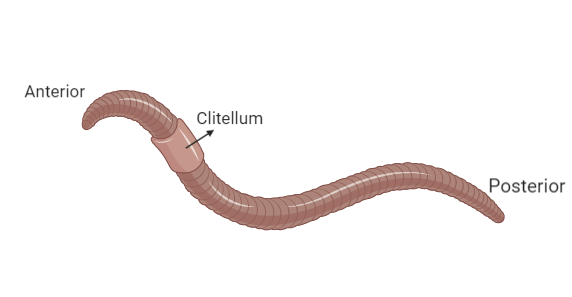
Animals of which phylum exhibit tube within tube structure?
A. Coelenterata
B. Platyhelminthes
C. Cestoda
D. Annelida
Answer
447k+ views
Hint:Most of the animals have a tube inside a tube body plan. In this scheme two openings are required: one to feed in the body (mouth), one to leave the body with waste (anus). The tube-in-one tube plan enables portions of the tube to be specialized, such as the liver, intestine, etc.
Complete answer:
The Phylum Annelida belongs to the kingdom of Animalia and is a very large phylum. The Annelids are present in habitats that are both marine and terrestrial. There are invertebrate species that are bilaterally symmetrical. They breathe through their body surface. Their segmented body separates them from any other creature. Their body contains hemoglobin, which gives them a red color. Most of the Annelids are hermaphrodite, i.e., there are male and female organs in the same body. They both sexually and asexually reproduce. The others sexually reproduce. The members of class Annelida are earthworms, ragworms, and leeches.

Coelenterata has only opening acts both as the mouth (food intake) and anus (digested waste passed out for the digestion of this kind of digestive tract are called incomplete animals with blind-sack species.
The bilateral corporeal plan of the Platyhelminthes has a head with a brain and a stereo eye that actively hunts it. Her mouth and pharynx are in the middle of her bottom and thus incomplete. The gut does not disperse food to other areas of the body without a circulatory system.
Cestoda has no digestive system, so they must eat food that another animal already digests. For this reason, they reside in our intestines as a parasite. They remain bound to the intestines of the host.
The tube within a tube is the annelid body plan. This means that in the coelomic cavity there is a superficial blanket of muscle, epidermis, and cuticle and an internal blanket of the digestive system.
Hence, the correct answer is option D- Annelida.
Note:
The tube in a tube expression is a simple way to think of the structure of the nematode body and is often used to refer to a significant pattern in triploblastic metazoan evolution (Brusca and Brusca, 1990 Invertebrates). The creation of a fluid-filled cavity from the outer wall of the body to the digestive tract. The existence of this cavity resulted in three grades of metazoan, acoelomate, pseudocoelomate, and eucoelomates (Brusca and Brusca, 1990 figures) being grouped together.
Complete answer:
The Phylum Annelida belongs to the kingdom of Animalia and is a very large phylum. The Annelids are present in habitats that are both marine and terrestrial. There are invertebrate species that are bilaterally symmetrical. They breathe through their body surface. Their segmented body separates them from any other creature. Their body contains hemoglobin, which gives them a red color. Most of the Annelids are hermaphrodite, i.e., there are male and female organs in the same body. They both sexually and asexually reproduce. The others sexually reproduce. The members of class Annelida are earthworms, ragworms, and leeches.

Coelenterata has only opening acts both as the mouth (food intake) and anus (digested waste passed out for the digestion of this kind of digestive tract are called incomplete animals with blind-sack species.
The bilateral corporeal plan of the Platyhelminthes has a head with a brain and a stereo eye that actively hunts it. Her mouth and pharynx are in the middle of her bottom and thus incomplete. The gut does not disperse food to other areas of the body without a circulatory system.
Cestoda has no digestive system, so they must eat food that another animal already digests. For this reason, they reside in our intestines as a parasite. They remain bound to the intestines of the host.
The tube within a tube is the annelid body plan. This means that in the coelomic cavity there is a superficial blanket of muscle, epidermis, and cuticle and an internal blanket of the digestive system.
Hence, the correct answer is option D- Annelida.
Note:
The tube in a tube expression is a simple way to think of the structure of the nematode body and is often used to refer to a significant pattern in triploblastic metazoan evolution (Brusca and Brusca, 1990 Invertebrates). The creation of a fluid-filled cavity from the outer wall of the body to the digestive tract. The existence of this cavity resulted in three grades of metazoan, acoelomate, pseudocoelomate, and eucoelomates (Brusca and Brusca, 1990 figures) being grouped together.
Recently Updated Pages
Master Class 11 Accountancy: Engaging Questions & Answers for Success

Glucose when reduced with HI and red Phosphorus gives class 11 chemistry CBSE

The highest possible oxidation states of Uranium and class 11 chemistry CBSE

Find the value of x if the mode of the following data class 11 maths CBSE

Which of the following can be used in the Friedel Crafts class 11 chemistry CBSE

A sphere of mass 40 kg is attracted by a second sphere class 11 physics CBSE

Trending doubts
10 examples of friction in our daily life

Difference Between Prokaryotic Cells and Eukaryotic Cells

State and prove Bernoullis theorem class 11 physics CBSE

What organs are located on the left side of your body class 11 biology CBSE

Define least count of vernier callipers How do you class 11 physics CBSE

The combining capacity of an element is known as i class 11 chemistry CBSE




